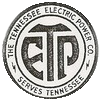Twenty-five years ago a small envelope with the above description was found, and kept by Arlene Rogers as she was assisting with settling the estate of a deceased church member. Recently she contacted Mark Kennedy, who I work with on a weekly basis for the popular 'Remember When Chattanooga' feature in the Chattanooga Times Free Press.
Like many other neighborhoods at the time, Glass Street’s business district was a self-contained economy. In this view estimated to be from the late 1930s, we see Red Food Stores, Bacon Drug Co., Contor’s Dry Goods, Shoes, and ‘Notions’, Jackson Hardware, a Mobilgas full service gas station, and even a movie theater – the Rivoli.
East Chattanooga was, for a short time, incorporated as a town; beginning in 1917. Annexation in 1925 rebranded the area as the Twelfth Ward of the City of Chattanooga.
Click to View
SOURCE:
From original photo
Boyce Line
In a second photo – a group of smiling ladies is seen in front of a Boyce Street Car. The photo is dated July 7, 1943. This would be from the last years of Chattanooga’s Street Railway operation. By then the former TEPCO was operating public transportation as “Southern Coach Lines” and phasing out street cars in favor of buses. A faded TEPCO logo can be seen on the car.

David H. Steinberg, an author, historian and avid collector of street car, railway and bus transportation ephemera grew up in Chattanooga. He describes ‘TEPCO's premeditated destruction of Chattanooga's street railway system’. This line remained active only because it was more profitable – along with the East Lake, St. Elmo and Alton Park lines.
Upon reaching Glass Street near the end of the line, Superintendent J. W. "Whiz" Anderson took over the controls of leading car #133. At the end of the line at Stuart and Dodson Avenue, he reversed the trolley quickly, late as they were, and both cars sped uneventfully back to the car barn at Market and Third Streets.
There, with a convulsive lurch and defiant final screech of the brakes, the Boyce trolley ground to a halt at 12:40 a.m. early Thursday morning, April 10, 1947.
Giving three final tugs at the bell, and switching off the lights, the motorman slid off the operator's perch and turned away to mark the finis of 58 years of electric streetcar service in Chattanooga.
Chattanooga Daily Times, Dec. 25, 1930
Photos stored away will likely never be seen.
Far too often, history is lost in settlement of estates or thrown away by well-meaning family members. Many public institutions and organizations are not set up to share, but rather to archive and garner donations.
Why ChattanoogaHistory.com is different.
No-charge photo & negative scanning is available for qualifying materials such as true photo (non-digital) prints, negatives, glass plate negatives, and 35mm slides.
I started this website in 2014 with the goal of sharing high-resolution historic photos from this region; invested in professional digital scanners, and other tools to ensure donated or loaned photos are quickly digitized. Originals and/or digital copies are provided back to you.
You or the original photographer (if known) are fully credited.
How to contact me
If you have qualifying historical photos to digitize and share - use the CONTACT form for a quick response.
